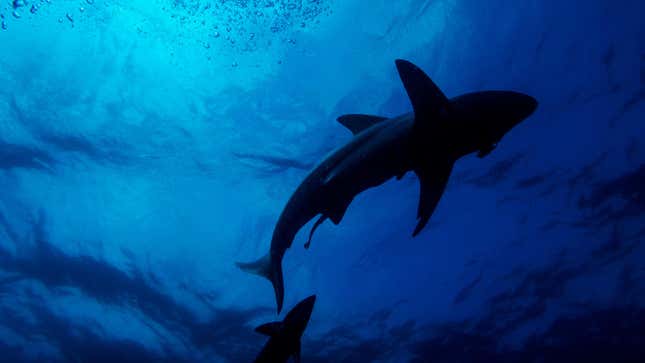
Sharks looking to escape danger are putting Florida residents in harm’s way.
Florida waters have been plagued by a severe red tide spurred by an algae that can be deadly to creatures as large as manatees. To escape the toxic slime, hundreds of coastal sharks have fled to a canal—like, one where humans hang out.
Last week, residents of Buttonwood Harbor, near Sarasota, recorded harrowing footage of hundreds of bonnethead, blacktip, nurse, and lemon sharks swimming in canals near their homes.
“It was like all of these fins and all of a sudden you would see a great big shark come underneath all the little ones and it was like ‘holy cow,’” Janelle Branowner, who recorded a video of the sharks on her phone, told a local Fox News affiliate.
Red tides can happen naturally and have been documented in Florida as far back as the 1840s, but they don’t generally result in sharks swimming toward humans to find refuge. Then again, red tides aren’t usually this serious and they normally occur in the autumn. Florida has seen just one summer red tide per decade in the past 30 years, the most recent being the destructive bloom of 2018.
“This is an unnatural thing. These sharks are not here through their own choice. They are there because they are seeking refuge from red tide which could kill them,” said Dr. Bob Hueter, the chief scientist of oceanic data organization Ocearch, told the local Fox station.
It’s the latest unnerving scene from Florida spurred by a massive red tide on the Gulf Coast in the Tampa area. Dead fish have been piling up across the region and already-threatened manatees have been dying in droves in part due to the toxic waters.
Though a direct link has not been proven, many have speculated that this year’s early and intense tide may have been supercharged by pollution from Piney Point, an old fertilizer plant. Piney Point discharged more than 2 million gallons of wastewater in April in an effort to prevent a catastrophic failure of the plant’s retaining walls holding back a reservoir full of pollutants like phosphorus and nitrogen. Warming ocean temperatures due to the climate crisis have also been linked to an increase in algal blooms, and it’s clear more research is needed to pinpoint what’s driving this year’s major red tide.
The scary situation shows how deeply out of whack Florida ecosystems currently are and the need for officials to change course. In 2019, Gov. Ron DeSantis reactivated Florida’s algal bloom task force to investigate these kinds of events, yet he has refused to issue a state of emergency order over the red tide, saying doing so would take a toll on the region’s tourism and economy. He has also consistently supported the oil and gas industry, which could exacerbate the risk of more toxic tides.
Needless to say, residents who are suddenly sharing their waterways with sharks are worried for their safety. But experts are also concerned about the creatures themselves; oxygen levels in the canal may not be high enough to support them for long.
“If the conditions are really bad outside that canal, they might be stuck until the conditions get to the point where there’s enough oxygen or there aren’t toxins if they were to leave the canals,” Mike Heithaus, a shark expert and biological sciences professor at Florida International University, told the Guardian. “But at the same time, if those conditions go south in the canal, there’s nowhere left to run.”